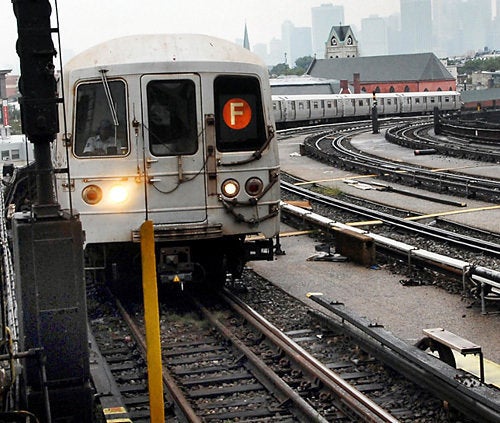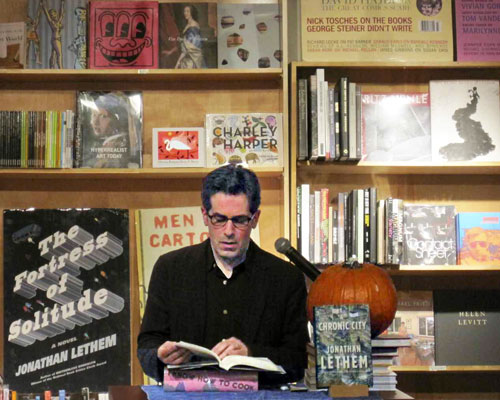
Last Friday night, Brooklyn born novelist Jonathan Lethem concluded a citywide marathon reading of his new book Chronic City with an impressive, nine-hour performance at Bookcourt bookstore, located in the Cobble Hill neighborhood where the author grew up. Lethem had pledged to read all 467 pages of the book over the course of a series of evenings around New York. Having fallen behind, he was obliged to enlist help; novelist Tom McCarthy, philosopher Simon Critchley and a few representatives from The National Theatre of The United States of America were on hand to share the burden of the microphone for a chapter or two.
Chronic City follows the charming yet ineffectual childhood TV star Chase Insteadman as he flutters around the Upper East Side from one dinner party to the next and is forced to navigate a string of phantasmagorical urban spectacles; an escaped giant tiger wreaks havoc up and down the avenues, a mysterious gray fog descends over the financial district, and a disconcerting, if delicious, chocolate smell envelops the borough.

Photograph courtesy of Jane Hanstein Cunniffe
Early on, Chase meets Perkus Tooth, an ex-rock critic who is as entrenched in his quixotic brand of paranoia as he is in the rent controlled, East 84th Street apartment where much of the novel -- which is replete, yes, with pot-fueled jaunts down esoterica lane -- takes place. Perkus gathers Chase under his wing, intent on tutoring our him in the broader implications of cultural phenomena like the "Gnuppets," and the genius of Marlon Brando.
It is in response to Perkus' whim, and along with Oona Lazlo, the accomplished underwriter, and Richard Abneg, a social justice advocate who now works for the mayor, the two embark upon an inane grail-quest for mysterious ceramics known as "chaldrons." (This mostly involves getting high and using Perkus' dial-up internet to bid for the things on eBay.) It is this obsession, aggravated by the discovery of "Yet Another World," which is Lethem's novelistic avatar, so to speak, for Second Life, that triggers in Perkus the realization that somehow, somewhere, the truth got lost. (It also lands him with a possibly life threatening case of the hiccups, which accounts for the caesurae in the following quote):
Something happened, Chase, there was some... rupture in this city. Since then, time's been fragmented. Might have to do with the gray... fog, that or some other disaster. Whatever the cause, ever since we've been living in... a place that's a replica of itself, a fragile simulacrum, full of gaps and... glitches. A theme park really!
Though this epiphany, spoken toward the end of Chronic City, may read like Baudrillard on, well... chronic, Lethem has been getting far too much flak for writing what Hari Kunzru in Bookforum cast off as a "stoner book," one "too good humored to attain satiric bite." Michico Kakutani, in an early review in the New York Times, had a similar gripe and blasted Lethem for generating characters that "inhabit neither a real-flesh and blood Manhattan, nor a persuasive fictional realm."
But, this is ultimately the author's point. His novel performs, at the narrative level, the mutual erosion of the fictive and the real that plagues its inhabitants. If these morally reprehensible figures fail to feel and react like human subjects it is because they are no longer capable of experiencing their own lives as unmediated and real. This is where the tragedy -- and there is tragedy -- inheres.
Take Insteadman who, as I haven't mentioned, is caught throughout the book in the longest of long distance relationships. His lover is Janice Trumbull, an astronaut stuck in orbit on the wrong side of an impassible field of Chinese mines and destined, it seems, for a slow death. She writes darkly humorous open letters to Chase, which are published in the "War Free" edition of the New York Times. Chase, either because of some kind of personal deficiency, some defensive hardening of the heart, or because things aren't really what they seem -- you just have to wonder which it is -- is incapable of manifesting the requisite grief. But there is a great deal of pathos in the absence of pathos, in Chase's inability to relate to what ought to be the most intimate of plights. I, for one, found the last several chapters of Chronic City to be absolutely devastating.
The novel is also full of entertaining one-liners, as when one of the characters compares the task of memorizing The Complete Writings of Robert Smithson to "ordering a month's worth of meals at a restaurant where John Cage is the chef." There are a number of clever references and lampoons. But no, you don't have to get all the allusions to get the book, which is, in part, an earnest and self-implicating jab at the kinds of people who do care about that sort of thing. (There is, after all, a bit of the author in all of his characters.) While some of the jokes are less critical than others, I find it hard to believe, considering the objects of parody Lethem all too obviously has in mind (and if you're still not clear, you can watch his explanation here) that anyone could come away not feeling the "satirical bite."
Needless to say, there was no time for a Q & A at Chronic City's final reading, but when it was all over and done at 4:11 on Saturday morning, as a few die-hard friends and fans beat their retreat, I asked Lethem how it felt to be finished with his publicity run. He responded with what may or may not have been, in the moment, a witty summation of the dialectic that drives his book: "I feel belief and... disbelief."